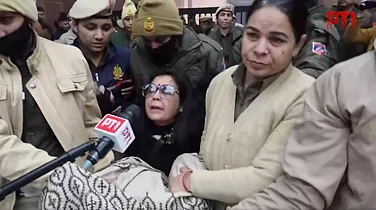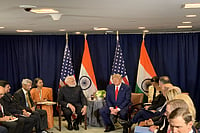Prime Minister Narendra Modi and US President Joe Biden co-chaired the launch of the India-Middle East-Europe Economic Corridor (IMEC) on Saturday on the sidelines of the G20 Summit, an ambitious inter-continental connectivity project.
The corridor would involve a railway network in the Middle East and shipping ports to connect India with Europe via the Middle East.
Besides Modi and Biden, the leaders part of the launch of the project included Saudi Arabia's Crown Prince Mohammed bin Salman, UAE UAE President Sheikh Mohamed, French President Emmanuel Macron, German Chancellor Olaf Scholz, Italian PM Giorgia Meloni, and the European Union (EU) President Ursula von der Leyen. Besides these countries, Israel and Jordan are also part of the project.
Modi hailed the signing of the IMEC project as historic and said "may this corridor be a testament to human endeavour and unity across continents".
For Modi and Biden, the IMEC is the major highlight of the G20 Summit. The project is also being seen as a major connectivity inititative that rivlas the Belt and Road Initiative (BRI) of China through which China has constructed a series of roads and ports in several parts of the world. The project has come under criticism for plunging countries into debt traps and propping 'white elephants'.
For India, the IMEC is the icing on the cake as the G20 Summit has so far ticked all the boxes: the joint declaration by consensus, inclusion of African Union (AU) as a permanent member under India's presidency, and the acceptance of the Indian agenda.
Leaders hail India-Middle East-Europe Economics Corridor
The India-Middle East-Europe Economic Corridor (IMEC) has been announced under the broader framework of the Partnership for Global Infrastructure and Investment (PGII).
Prime Minister Narendra Modi said, "Today we all have reached an important and historic partnership. In times to come, it will become effective medium for economic integration of India, Middle East, Europe. It will give new direction to connectivity and sustainable development of entire world."
US President Joe Biden Biden said the United States will invest in a new rail line from Angola towards the Indian Ocean.
He said, "This will generate jobs and enhance food security. This is a game-changing investment. The world stands at an inflection point in history. Together let's work as one."
Exuding confidence in the project, Italian Prime Minister Giorgia Meloni said, "This will scale up our economy's growth and benefit the business sector."
EU President Ursula von der Leyen, "The 'India-Middle East-Europe' economic corridor is historic. It will be the most direct connection till date that will make trade faster."
What do we know of India-Middle East-Europe Corridor?
The India-Middle East-Europe Economic Corridor (IMEC) has been launched under the broader framework of the Partnership for Global Infrastructure and Investment (PGII). The initiative was co-chaired by Prime Minister Narendra Modi and US President Joe Biden on the sidelines of the G20 Summit.
The plan of building the cross-border corridor is primarily designed to strengthen trade, transport energy resources and improve digital connectivity. The idea of building the multimodal transport and energy corridor originated when National Security Adviser (NSA) Ajit Doval met his US counterpart Jake Sullivan in May this year.
The corridor will also serve the purposes of transporting energy through pipelines and data through an optical fibre link besides regular trade and commerce.
"This will create novel interconnections to facilitate global trade, expand reliable access to electricity, facilitate clean energy distribution, and strengthen telecommunications links," said a fact-sheet published by the White House, calling the project "transformative partnership".
The IMEC will be comprised of two separate corridors: an eastern corridor connecting India with the Middle East and a northern corridor connecting Middle East further with Europe, said the White House.
The White House's fact-sheet listed the project's features:
- Connect India to Europe—linked by a railway line and existing ports through the UAE, Saudi Arabia, Jordan, and Israel—that will generate economic growth while incentivizing new investments and the creation of quality jobs;
- Connect two continents to commercial hubs and facilitate the development and export of clean energy;
- Support existing trade and manufacturing synergies and strengthen food security and supply chains; and
- Link energy grids and telecommunication lines through undersea cables to expand reliable access to electricity, enabling innovation of advanced clean energy technology and connect communities to secure and stable Internet
Initially, it was reported that the project would at first involve India, the United States, UAE, and Saudi Arabia, and would expand to include Israel once relations between Israeli and the Saudis are normalised. But now it appears that the project has been launched with an expanded vision from the onset.
The project is also being seen as the US project of further integrating and stabilising the Middle Eastern region, which was for decades defined by the Arab countries' opposition to Israel over the Palestinian issue. But, with support from the United States, the Arab countries in the region have started to make peace with Israel. China also has considerable interest in the region and is engaging with the countries and any India- and US-led project in the region would counter Chinese influence.


























